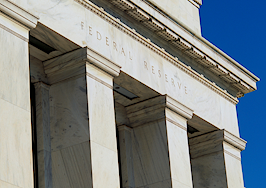Mortgage rates have rebounded to levels not seen since July following signals from the Federal Reserve last week that it could start scaling back its purchases of mortgages and long-term Treasury bonds later this year.
The Fed’s debt purchases have helped keep long-term interest rates low. But that’s not all that may be spooking investors who buy mortgage debt. There’s also the fast approaching U.S. debt ceiling deadline, and uncertainty over who will be leading the Federal Reserve next year.
While it’s too soon to say whether the forces that are driving up long-term interest rates will be long-lasting, housing industry leaders are keeping a close eye on the rise in mortgage rates, which could limit the buying power of would-be homebuyers, denting home sales and prices.
Since a Sept. 22 press conference where Fed policymakers made it clear they could start tapering the Fed’s debt purchases later this year, Optimal Blue data shows mortgage rates have climbed 11 basis points — from 3.067 percent on Tuesday, Sept. 21, to 3.181 percent Monday, Sept. 27.
Rates on 10-year Treasury notes — a bellwether for where mortgage rates are headed — have jumped 20 basis points through Tuesday, Sept. 28.
Optimal Blue Mortgage Market Indices
If temporary, that kind of volatility is not unusual and can actually serve to get would-be homebuyers off the fence because they want to lock in rates, said Fannie Mae Deputy Chief Economist Mark Palim.
As recently as November 2018, average rates on 30-year fixed-rate mortgages were approaching 5 percent, so today’s rates “are still pretty low by historical standards,” Palim said.

Mark Palim
“If you had a long and sustained increase in mortgage rates, that would be more concerning to me,” Palim said, pointing to recent weakness in homebuyer sentiment in Fannie Mae’s monthly National Housing Survey.
In the latest survey, 63 percent of consumers said they thought it was a bad time to buy a home, frequently citing high home prices and a lack of supply as reasons.
A big jump in interest rates, like the “taper tantrum” of 2013, can have an impact on home prices and sales, Palim said. In the 2013 taper tantrum, mortgage rates soared by more than 100 basis points — a full percentage point — in just eight weeks.
“We saw home sales drop by 10 percent, and home price appreciation slow,” in the wake of the taper tantrum, Palim said.

Lawrence Yun
Lawrence Yun, chief economist for the National Association of Realtors, called the recent lift in long-term interest rates overdue.
“Though it may be due to uncertainty arising from brinkmanship on U.S. debt default, I believe it is from the greater recognition of higher inflation,” Yun said via email. “The Federal Reserve has been revising up its inflation forecast and the Fed chairman Powell has changed his narrative to imply as such.”
Higher inflation for a longer period “means that lenders want additional compensation for the loss in purchasing power of the dollar when the borrowed money is returned at a future date,” Yun said. “That is why the 10-year Treasury yield is rising and, consequently nudging up mortgage rates.”
The Fed’s influence on long-term rates
While the Federal Reserve has tight control over the short-term federal funds rates, it’s only one of a number of players in the market for long-term debt.
The ultimate source of funding for most U.S. mortgages are investors who buy mortgage-backed securities (MBS) guaranteed by Fannie Mae, Freddie Mac and Ginnie Mae. More investor demand for MBS can drive down rates paid by borrowers.
During the pandemic, the Fed has been one of those investors, increasing its MBS holdings by $40 billion a month, while also bolstering its holdings of government debt by $80 billion a month.
The Fed’s emergency debt purchases are credited with helping keep long-term interest rates low. In Freddie Mac records dating back to 1971, rates on 30-year fixed-rate mortgages hitting an all-time low of 2.65 percent during the week ending Jan. 7, 2021.
The debt purchases “were very, very important in the early stages of the crisis,” Federal Reserve Chairman Jerome Powell said last week. “Now we are in a situation where they still have a use, but it’s time for us to begin to taper them. Their usefulness is much less as a tool than it was at the very beginning.”
With the Fed now holding nearly $8 trillion in mortgage and government debt, Powell and other members of the Fed’s board of governors have been laying the groundwork for tapering in recent months. By telegraphing their intentions, Fed policymakers hope to avoid an investor panic like the “taper tantrum” of 2013, when the Fed was considering slowing down the debt purchases undertaken during the 2007-09 financial crisis and recession.
While the Fed deliberated tapering behind closed doors in early 2013, the public didn’t get wind of it until then Chairman Ben Bernanke testified before Congress on May 22, 2013, according to an analysis by Reuters when the full meeting transcripts were released in 2019.
Impact of 2013 ‘taper tantrum’ on mortgage rates
In just eight weeks, rates on 30-year fixed-rate mortgage rates shot up by 111 basis points, from 3.35 percent during the week ending May 2, to 4.46 percent on June 27. By Aug. 22, rates had hit their 2013 peak of 4.58 percent.
“The lessons of that year echo today, as Fed policymakers again debate the fate of the central bank’s massive balance sheet and struggle with the market turmoil that results when investor expectations on policy are at odds with their own,” Reuters noted in its analysis.
The Fed had only begun to wind down the massive debt purchases it made to bolster the economy after the 2007-09 recession when the pandemic hit. Today, with the debt on the Fed’s balance sheet from quantitative easing approaching $8 trillion, policymakers want to trim the Fed’s holdings — in part, so it will be able to respond to the next crisis.
Fed quantitative easing approaching $8 trillion
Uncertainties about debt ceiling and Fed leadership
In addition to worries about the potential impact of Fed tapering, there’s also uncertainty about the approaching U.S. debt ceiling and the future leadership of the Fed.
Congress is deadlocked on raising or suspending the cap on how much the government can borrow, Politco reports, with both parties playing chicken as Democrats try to pass a bill authorizing trillions in spending on social programs. In the meantime, Treasury Secretary Janet Yellen is warning that Congress has only about three weeks to act.
“We now estimate that Treasury is likely to exhaust its extraordinary measures if Congress has not acted to raise or suspend the debt limit by October 18,” Yellen warned Tuesday in a letter to Speaker of the House Nancy Pelosi. “At that point, we expect Treasury would be left with very limited resources that would be depleted quickly.”
From previous impasses, Yellen said, “We know … that waiting until the last minute can cause serious harm to business and consumer confidence, raise borrowing costs for taxpayers, and negatively impact the credit rating of the United States for years to come. Failure to act promptly could also result in substantial disruptions to financial markets, as heightened uncertainty can exacerbate volatility and erode investor confidence.”
When Congress waited until the last minute to raise the debt ceiling in 2013, rates on long-term Treasurys jumped by 21 to 46 basis points, according to an analysis by The Brookings Institution’s Hutchins Center on Fiscal & Monetary Policy.
Politics are also creating some uncertainty over the Federal Reserve’s future policies. Not only is Powell’s term as Fed chairman set to expire in February, but the Biden administration could appoint as many as three new members in the months ahead, with two governors’ terms expiring and a vacant seat that needs to be filled.
At a Senate Banking Committee hearing Tuesday, Sen. Elizabeth Warren told Powell to his face that she would oppose his renomination, saying his record on financial regulation “gives me grave concern.”
“You have acted to make our banking system less safe, and that makes you a dangerous man to head up the Fed and that is why I will oppose your renomination,” Warren said.
But Powell has Yellen’s support, and “could probably still count on bipartisan support for confirmation” if nominated by the Biden administration for a second term, Bloomberg reports.
Impact of interest rates on housing
Mortgage rates can have a big impact on how much home a buyer can afford, but there’s an ongoing debate over how much of an impact mortgage rates have on housing sales and housing prices.
If a homebuyer can afford to pay $2,000 a month, they can qualify for a $475,000 mortgage with a 3 percent interest rate. But if the same homebuyer has to pay 4 percent interest, they can only afford to borrow $420,000. At 5 percent interest, a homebuyer who can afford a $2,000 monthly mortgage payment can’t borrow much more than $375,000.
So on paper at least, each 1 percentage point increase in the mortgage rate decreases their buying power by about $50,000. That simple analysis doesn’t take into account taxes and fees, or how much the homebuyer has saved for a downpayment.
Home prices and sales are also affected by the availability of mortgage credit, the supply of listings and the pace of new home construction.
A recent analysis by New York Fed economists concluded that the low interest rates homebuyers have enjoyed during the pandemic can only explain part of the rapid recent increase in home values. Low interest rates have had a bigger impact on home sales and new home construction, which “are very sensitive to interest rates,” the report said.
Another survey-based academic study found that changes in mortgage rates have only a moderate effect on consumers’ willingness to buy a home under different financial scenarios. An increase in household wealth or the ability to buy a house with a smaller down payment had a bigger effect on willingness to buy, the study found.












